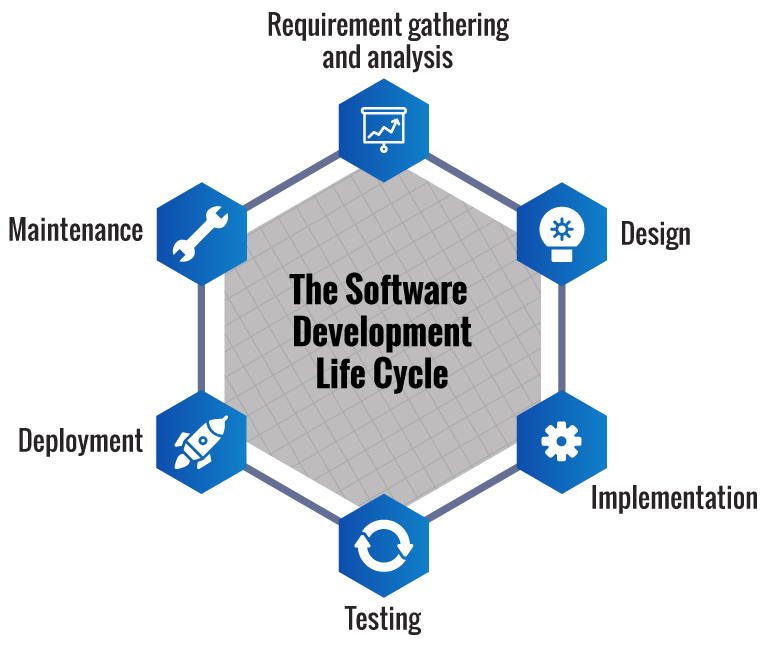What happens during a software development project? Is there more to it than a collection of introverted techie engineers sipping coffee from Star Wars-branded mugs? In this article, we provide a broad overview of the process you can expect to follow when partnering with a team of software developers.
So you’re ready to take the steps toward automating your business processes and you’ve engaged with or are ready to engage with a development company to deliver the software that will transform the way you do things.
Unless you have experience working in software development, you might be mystified by the way the software team works, or why the process seems to be far more ‘involved’ than you expected. The media may have led you to believe that software developers are like Tank from The Matrix, who can take you from couch potato to Bruce Lee within seconds of frantic keyboard action.
If that’s what you want, you may be able to get a software package that prints the word “Hello, world” to your computer screen, but I doubt that will help you much. Good software is an ongoing commitment and requires adherence to industry best practices. To begin to understand why and how software teams do what they do, you need to start by understanding the Software Development Life Cycle.
The Software Development Life Cycle - Defined
The term “Software Development Life Cycle” (SDLC for short) is an umbrella term for a range of systematic processes followed by development teams to ensure the software produced is of the highest quality and meets the customers’ needs and expectations.
The SDLC concept has been around more or less as long as computers have, originating more or less at the same time as the original SDLC framework known as the Waterfall Model in the 1950s. The ideas around how best to deliver a software project have changed a lot since then and, despite remaining pervasive, the Waterfall Model is generally considered outdated.
The Components of the SDLC
Despite the variety of specific instances of SDLCs today, all of them typically include a consistent set of general components. This list of components can, of course, be expressed in a variety of ways, but in general, an SDLC will include the following components:
- Requirement gathering and analysis - it’s hard enough as a business executive to conceptualise and describe the rules and processes that software needs to perform for your business; so consider that your development team are a group of specialists who nevertheless need to cover a lot of ground in terms of understanding your business needs.
This is why every software project necessarily includes a period of information-gathering, in order to clarify what exactly needs to be accomplished.
It's especially important as the customer to be heavily involved here to ensure that your needs are fully understood.
Once the requirements are detailed, they are typically analysed to determine the feasibility of implementing the proposed solution. - Design - during this phase the project requirements are consulted in order to determine the hardware, system and architectural requirements of the project. The conceptual design and logic of the software are documented. At this point, the software testers can also document the tests that will be necessary to ensure that the developed software meets the requirements.
- Implementation - here’s the part where the developers do their coding. However, this is not the time for you to punch out and give the team the silent treatment. As the customer, you are valuable during every stage of the project.
- Testing - the laws of nature virtually guarantee that somewhere between the first line of code and the last at least one mistake, or ‘bug’, will creep in. Or sometimes a developer may be too limited by the scope of his particular coding task and loses sight of the bigger picture. Every successful software programme has a team of dedicated software testers behind the scenes who ensure that bugs are squashed and that the emerging programme continues to fulfil and exceed the requirements and expectations of the customer.
In addition, the customer itself will engage in ‘User Acceptance Testing’ in a testing environment to ensure the software is up to scratch. Both QAT and UAT are essential components for the delivery of a successful software project. - Deployment - the software has been coded and tested. Now it’s time to release the software to the customer for real-life use.
- Maintenance - the code has been coded and tested and deployed, so we’re done now right? In today’s world of technology and business, things change far too drastically and quickly for one-time solutions. As you use your software and as your business needs alter, you will inevitably need development support from your software team to keep optimising the effectiveness and efficiency of your business software.

It’s important to note that these individual stages are not necessarily one-time events in chronological order; modern SDLCs typically implement these components on a recurring/continuous basis.
At SOLIDitech, we live all of the stages mentioned above on a daily basis. As experts in the Internet Service Provider industry, we value close and continuous collaboration with our clients to ensure optimal automation of tedious administrative business processes. Our expert team of software engineers and quality assurance analysts are dedicated to ensuring that implementation and testing yield useful software that exceeds customer expectations.
What’s the point of following an SDLC?
Adopting a well-defined SDLC and rejecting mod podge development processes has a variety of benefits:
- Emphasising careful investigation of customer needs and the development of precise project goals
- An emphasis on releasing carefully developed and quality software
- Standardising and providing a common language for the development process, thereby increasing team harmony
- Clarifying team roles and responsibilities
Understanding the SDLC and how it works forms part of improving your technical understanding. If you're about to embark on a new software project, you'll need strong software project management, effective communication, good feedback loops, testing, technical understanding and customer involvement for a successful outcome. Let me talk you through each of these for this ‘ultimate software project management guide’.








Comment